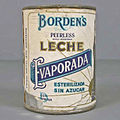Evaporated milk
Evaporated milk, also known as dehydrated milk, is a type of milk product where approximately 60% of the water content has been removed. The process of creating evaporated milk involves exposing the milk to heat until a significant portion of the liquid evaporates. This results in a concentrated, nutrient-rich product that has a longer shelf life than regular milk.
History[edit]
The concept of evaporated milk was developed in the 19th century as a way to preserve milk without the need for refrigeration. The first patent for the process was granted to Gail Borden in 1856, who sought a way to provide safe, stable milk to urban populations and seafaring voyagers.
Production[edit]
The production of evaporated milk begins with the pasteurization of milk to eliminate any harmful bacteria. The pasteurized milk is then concentrated under reduced pressure to lower the boiling point and prevent the milk from scorching. The resulting product is then homogenized, packaged, and sterilized to ensure its safety and longevity.
Uses[edit]
Evaporated milk is used in a variety of cooking and baking applications. Its concentrated nature gives it a slightly caramelized flavor and a creamier texture than regular milk, making it ideal for use in desserts, sauces, and soups. It can also be reconstituted with water to be used as a substitute for fresh milk in recipes.
Nutritional Value[edit]
Due to the evaporation process, evaporated milk has a higher concentration of nutrients than regular milk. It is a good source of protein, calcium, and vitamin D. However, it also has a higher concentration of sugar and calories due to the caramelization during the evaporation process.
See Also[edit]
Evaporated milk[edit]
-
Evaporated milk
-
Evaporated milk
Ad. Transform your life with W8MD's Budget GLP-1 injections from $75


W8MD offers a medical weight loss program to lose weight in Philadelphia. Our physician-supervised medical weight loss provides:
- Weight loss injections in NYC (generic and brand names):
- Zepbound / Mounjaro, Wegovy / Ozempic, Saxenda
- Most insurances accepted or discounted self-pay rates. We will obtain insurance prior authorizations if needed.
- Generic GLP1 weight loss injections from $75 for the starting dose.
- Also offer prescription weight loss medications including Phentermine, Qsymia, Diethylpropion, Contrave etc.
NYC weight loss doctor appointmentsNYC weight loss doctor appointments
Start your NYC weight loss journey today at our NYC medical weight loss and Philadelphia medical weight loss clinics.
- Call 718-946-5500 to lose weight in NYC or for medical weight loss in Philadelphia 215-676-2334.
- Tags:NYC medical weight loss, Philadelphia lose weight Zepbound NYC, Budget GLP1 weight loss injections, Wegovy Philadelphia, Wegovy NYC, Philadelphia medical weight loss, Brookly weight loss and Wegovy NYC
|
WikiMD's Wellness Encyclopedia |
| Let Food Be Thy Medicine Medicine Thy Food - Hippocrates |
Medical Disclaimer: WikiMD is not a substitute for professional medical advice. The information on WikiMD is provided as an information resource only, may be incorrect, outdated or misleading, and is not to be used or relied on for any diagnostic or treatment purposes. Please consult your health care provider before making any healthcare decisions or for guidance about a specific medical condition. WikiMD expressly disclaims responsibility, and shall have no liability, for any damages, loss, injury, or liability whatsoever suffered as a result of your reliance on the information contained in this site. By visiting this site you agree to the foregoing terms and conditions, which may from time to time be changed or supplemented by WikiMD. If you do not agree to the foregoing terms and conditions, you should not enter or use this site. See full disclaimer.
Credits:Most images are courtesy of Wikimedia commons, and templates, categories Wikipedia, licensed under CC BY SA or similar.
Translate this page: - East Asian
中文,
日本,
한국어,
South Asian
हिन्दी,
தமிழ்,
తెలుగు,
Urdu,
ಕನ್ನಡ,
Southeast Asian
Indonesian,
Vietnamese,
Thai,
မြန်မာဘာသာ,
বাংলা
European
español,
Deutsch,
français,
Greek,
português do Brasil,
polski,
română,
русский,
Nederlands,
norsk,
svenska,
suomi,
Italian
Middle Eastern & African
عربى,
Turkish,
Persian,
Hebrew,
Afrikaans,
isiZulu,
Kiswahili,
Other
Bulgarian,
Hungarian,
Czech,
Swedish,
മലയാളം,
मराठी,
ਪੰਜਾਬੀ,
ગુજરાતી,
Portuguese,
Ukrainian


